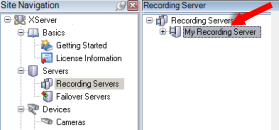Recording server (explained)
The recording server is responsible for communicating with the network cameras and video encoders, recording the retrieved audio and video as well as providing client access to both live and recorded audio and video. The recording server is also responsible for communicating with other Milestone products connected via the Milestone Interconnect technology.
- Network cameras and video encoders communicate through a device driver developed specifically for individual devices or a series of similar devices from the same manufacturer
- From the 2018 R1 release, the device drivers are split into two device packs: the regular device pack with newer drivers and a legacy device pack with older drivers
- The regular device pack is installed automatically when you install the recording server. Later, you can update the drivers by downloading and installing a newer version of the device pack
- The legacy device pack can only be installed if the system has a regular device pack installed. The drivers from the legacy device pack are automatically installed if a previous version is already installed on your system. It is available for manual download and installation on the software download page (https://www.milestonesys.com/downloads/)
- The recording server stores the retrieved audio and video data in the tailor-made high-performance media database optimized for recording and storing audio and video data
- The media database supports various unique features like; multistage archiving, video grooming, encryption, and adding a digital signature to the recordings
The system uses recording servers for recording of video feeds, and for communicating with cameras and other devices. A surveillance system typically consists of several recording servers.
Recording servers are computers where you have installed the Recording Server software, and configured it to communicate with the management server. You can see your recording servers in the Overview pane when you expand the Servers folder and then select Recording Servers.

Backward compatibility with recording server versions older than this version of the management server is limited. You can still access recordings on recording servers with older versions, but if you want to change their configuration, make sure they match this version of the management server. Milestone recommends that you upgrade all recording servers in your system to the same version as your management server.
The recording server supports encryption of data streams to the clients and services. For more information, see Encryption to clients and servers that retrieve data from the recording server (explained):
The recording server also supports encryption of the connection with the management server. For more information, see Encryption from the management server to the recording server (explained):
You have several options related to management of your recording servers:
When the Recording Server service is running, it is very important that Windows Explorer or other programs do not access Media Database files or folders associated with your system setup. If they do, it is likely that the recording server cannot rename or move relevant media files. This might bring the recording server to a halt. To restart a stopped recording server, stop the Recording Server service, close the program accessing the relevant media file(s) or folder(s), and restart the Recording Server service.

